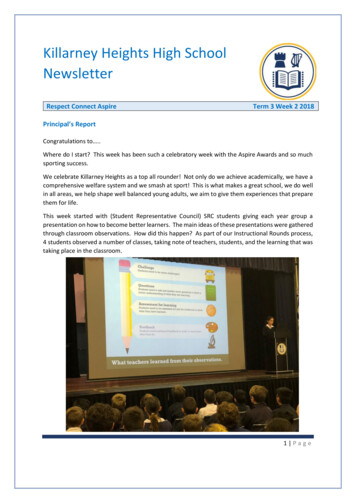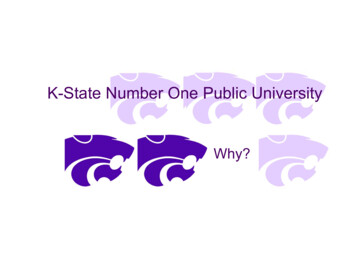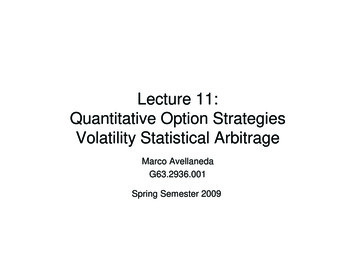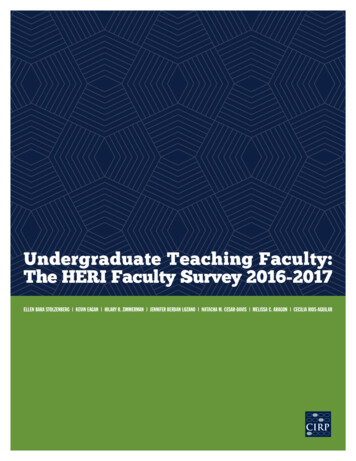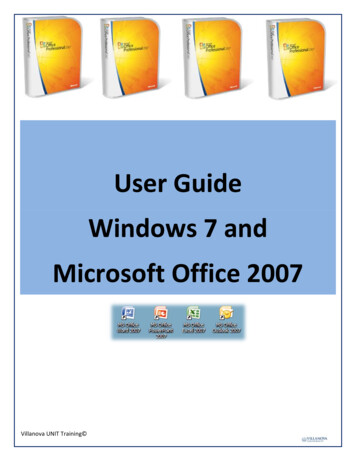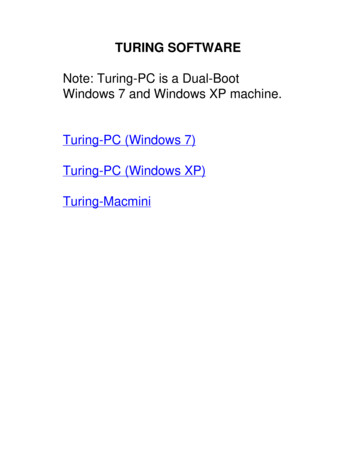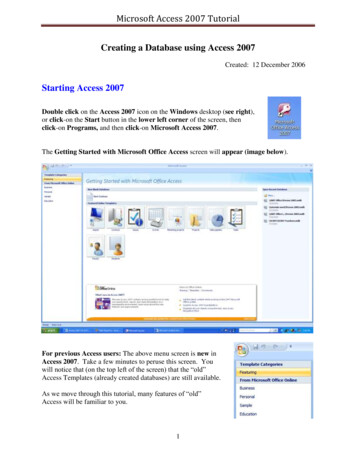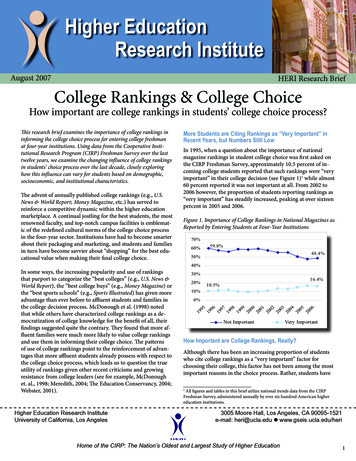
Transcription
August 2007HERI Research BriefCollege Rankings & College ChoiceHow important are college rankings in students’ college choice process?This research brief examines the importance of college rankings ininforming the college choice process for entering college freshmanat four-year institutions. Using data from the Cooperative Institutional Research Program (CIRP) Freshman Survey over the lasttwelve years, we examine the changing influence of college rankingsin students’ choice process over the last decade, closely exploringhow this influence can vary for students based on demographic,socioeconomic, and institutional characteristics.The advent of annually published college rankings (e.g., U.S.News & World Report; Money Magazine, etc.) has served toreinforce a competitive dynamic within the higher educationmarketplace. A continual jostling for the best students, the mostrenowned faculty, and top-notch campus facilities is emblematic of the redefined cultural norms of the college choice processin the four-year sector. Institutions have had to become smarterabout their packaging and marketing, and students and familiesin turn have become savvier about “shopping” for the best educational value when making their final college choice.More Students are Citing Rankings as “Very Important” inRecent Years, but Numbers Still LowIn 1995, when a question about the importance of nationalmagazine rankings in student college choice was first asked onthe CIRP Freshman Survey, approximately 10.5 percent of incoming college students reported that such rankings were “veryimportant” in their college decision (see Figure 1)1 while almost60 percent reported it was not important at all. From 2002 to2006 however, the proportion of students reporting rankings as“very important” has steadily increased, peaking at over sixteenpercent in 2005 and 2006.Figure 1. Importance of College Rankings in National Magazines asReported by Entering Students at Four-Year Institutions70%59.8%60%48.4%50%40%Higher Education Research InstituteUniversity of California, Los Angeles30%16.4%20%10.5%10%060520042003Not Important20022001200020992098199719961919950%19In some ways, the increasing popularity and use of rankingsthat purport to categorize the “best colleges” (e.g., U.S. News &World Report), the “best college buys” (e.g., Money Magazine) orthe “best sports schools” (e.g., Sports Illustrated) has given moreadvantage than ever before to affluent students and families inthe college decision process. McDonough et al. (1998) notedthat while others have characterized college rankings as a democratization of college knowledge for the benefit of all, theirfindings suggested quite the contrary. They found that more affluent families were much more likely to value college rankingsand use them in informing their college choice. The patternsof use of college rankings point to the reinforcement of advantages that more affluent students already possess with respect tothe college choice process, which leads us to question the trueutility of rankings given other recent criticisms and growingresistance from college leaders (see for example, McDonoughet. al., 1998; Meredith, 2004; The Education Conservancy, 2004;Webster, 2001).Very ImportantHow Important are College Rankings, Really?Although there has been an increasing proportion of studentswho cite college rankings as a “very important” factor forchoosing their college, this factor has not been among the mostimportant reasons in the choice process. Rather, students haveAll figures and tables in this brief utilize national trends data from the CIRPFreshman Survey, administered annually by over six hundred American highereducation institutions.13005 Moore Hall, Los Angeles, CA 90095-1521e-mail: heri@ucla.edu l www.gseis.ucla.edu/heriHome of the CIRP: The Nation’s Oldest and Largest Study of Higher Education1
consistently reported a school’s “good academic reputation” asthe top reason for choosing their college, along with whethergraduates of their college get good jobs, the size of the campus,the financial assistance they were offered, the school’s reputation for social activities, and whether the graduates of thatschool gain admission to top graduate or professional programs.When placed in the appropriate context, college rankings aremuch lower in relative importance for students in making theircollege choice. Thus, it appears that rankings serve as a sort ofconfirmation of perceived academic reputation or educationalexcellence, perhaps reinforcing a student’s ultimate collegechoice rather than guiding it in any meaningful way.Nonetheless, the influence of rankings in the college decisionprocess has been increasing in the last decade. Over the twelveyears that we have asked this question of students (1995 to2006), there has been a 56.2 percent increase in the proportionof students who report rankings are “very important” whendeciding where to go to college. By contrast, the four reasonsthat the largest proportion of students consistently rated “veryimportant” showed only very small relative increases. While itis apparent that rankings are not the most important issue thatstudents take under consideration when selecting their college,they are nonetheless becoming increasingly more important tostudents nationally.To Whom are Rankings Important?CIRP Freshman Survey data for the last 12 years point to arise in importance for college rankings among entering collegestudents. However, rankings seem to have much more of aninfluence for some groups of students than for others.Institution TypeThe proportion of students who reported that rankings were“very important” to them varied drastically by the type ofinstitution that students decided to attend. In general, the moreselective the institution, the higher the percentage of studentswho reported rankings were an important reason for attendingthat institution.2 In both 1995 and 2006, approximately elevenpercent or fewer of the students at low selectivity institutionsreported that rankings were “very important” to them, compared to approximately twenty percent or more of students athigh selectivity institutions. Further, in general, fewer studentsat public institutions and more students at private and non-sectarian institutions reported that rankings were a “very important” factor in their choice.Students at private, highly selective universities were by far themost likely to report that rankings were “very important” tothem (in 1995 32.0% and in 2006 42.6% did so), although students at highly selective public universities were also very likelyto report that rankings were “very important” in their selection(21.4% of students in 1995 and 24.4% in 2006 did so). Studentsat low selectivity 4-year non-Catholic religious colleges andstudents at public 4-year colleges were the least likely to reportthat rankings were “very important” in their selection choicein both 1995 and 2006. In addition, students at non-sectarian4-year colleges were particularly likely to report that rankingswere “very important” when they were at high- or very highselectivity institutions.The selectivity of a school is based on the mean score of entering freshmen onthe Verbal plus Mathematical portions of the Scholastic Aptitude Test (or theconverted SAT Math and Verbal equivalents from the American College Testcomposite).22
Race/EthnicityIn both 1995 and 2006, students who identified themselves asWhite/Caucasian were the least likely to indicate that rankingswere “very important” in their college choice. Asian or AsianAmerican students were most likely to report rankings as a“very important” factor in choosing their college. Hispanic andAfrican American students rated rankings similarly in 1995, butby 2006 African American students were second behind Asianstudents in citing rankings as “very important.” In sum, allstudent groups demonstrated a consistent increase in reporting that rankings were a “very important” factor in the collegechoice process.Figure 2. Percent citing rankings as “very important,”by Race/Ethnicity30%25.118.620%10%9.613.0 12.515.017.920.20%1995WhiteHispanicAlthough there has been an increasingproportion of students who cite collegerankings as a “very important” factorfor choosing their college, this factorhas not been among the most importantreasons in the choice process.SAT Score3The higher a student’s SAT score, the more likely he or shereported that rankings were an important factor in their collegechoice. In both 1995 and 2006, students whose SAT scores wereabove 1300 were by far the most likely to report that rankingswere “very important”—these students were about twice aslikely to cite rankings as “very important” than students whoseSAT scores were 900 or lower. Students whose SAT scores fellbetween 901 and 1299 were about as likely as the overall average to report that rankings were “very important.”2006African AmericanAsianFigure 3. Percent citing rankings as “very important,” by SAT score30%MajorStudents who intended to major in technical or professionoriented fields were the most likely to report that rankings werea “very important” influence in their college selection process,and students who intended to major in the social sciencesor arts/humanities were the least likely to report that rankings were a “very important” reason in choosing their college.Specifically, in both 1995 and 2006, students who reported theyplanned to major in such fields as engineering/technical, business, or the natural sciences were far more likely to cite rankings as “very important” compared to their peers intending tomajor in the social sciences or arts/humanities. Students whowere undecided about a major were the least likely to reportthat rankings were “very important” in their college selection,although in 2006, almost the same proportion of undecidedstudents cited rankings as “very important” as did those whointended to major in 5900 or below2006901-12991300 or aboveRace/Ethnicity by Parental Income LevelAlmost without exception, across all income groups, White/Caucasian students were the least likely to report that rankings were “very important” and Asian American students werethe most likely. African American and Hispanic students inthe highest income bracket were also very likely to report thatrankings were a “very important” influence for them. Interestingly, for all racial/ethnic groups in 1995, there was a trend ofmore students reporting rankings were “very important” astheir household income increased, and in 2006 this was also thecase for White/Caucasian, African American, and Hispanic/Latino students. However, for Asian-American students in 2006,the trend across income groups was virtually flat—the percent of Asian-American students who reported rankings were“very important” was between 24 and 28 percent, regardless ofincome.SAT scores in this report represent the Verbal plus Mathematical portions of theScholastic Aptitude test, or the converted SAT Math and Verbal equivalents fromthe American College Test composite.33
Figure 4: Percent citing rankings as “very important,” byrace/ethnicity and incomeReferencesEducation Conservancy (2004). Letter signed by college presidents petitioning against their institution’s participation in theUS News & World Report annual college rankings. Available fordownload on the world wide web at:http://www.educationconservancy.org/presidents letter.html.McDonough, P.M., Antonio, A.L., Walpole, M., & Perez, L.X.(1998). College rankings: Democratized college knowledge forwhom? Research in Higher Education, 39, 5: 513-537.Meredith, M. (2004). Why do universities compete in the ratings game? An empirical analysis of the effects of the U.S. Newsand World Report college rankings. Research in Higher Education, 45, 5: 443-461.Webster, T. (2001). A principal component analysis of the U.S.News & World Report tier rankings of colleges and universities.Economics of Education Review, 20, 3: 235-244.SummaryFrom 1995 to 2006, CIRP Freshman Survey trends data demonstrated a steady increase in the proportion of freshmen atfour-year institutions who reported that rankings were “veryimportant” in affecting their college decision. Situated withinthe broader context of other influences guiding college choice,college rankings appear to be growing in importance as aresource for some students. This is especially true for studentsfrom more affluent backgrounds, for those majoring in technical or business fields, for those with higher SAT scores, or thoseenrolled at selective institutions across different sectors. In spiteof these important contextual differences across different student groups, college rankings continue to “rank” relatively lowcompared to other factors guiding a student’s college choice.Our exploratory analysis has yielded a more nuanced portraitof the importance of rankings relative to other influences,revealing, perhaps, that rankings serve as more of an additionalconfirmation of an institution’s academic reputation, social andacademic offerings, and educational value rather than guidingstudents’ college choice in any meaningful way. Admissionsofficers and administrators should understand that rankings areonly one of many tools that today’s college students will utilizein guiding their college choice.In spite of the growing opposition and criticisms over theirinherent value, the use of college rankings as an informationresource for students and their families appears to be a permanent fixture in the college choice process.If you would like to discuss or comment onthis research brief, please f 18Higher Education Research InstituteUniversity of California, Los AngelesThe Cooperative Institutional Research ProgramCIRP is a national longitudinal study of the Americanhigher education system. It is regarded as the mostcomprehensive source of information on college students. Established in 1966 at the American Councilon Education, the CIRP is now the nation’s largest andoldest empirical study of higher education, involving dataon some 1,900 institutions and over 12 million collegestudents. The Higher Education Research Institute hasadministered the CIRP since 1973. The CIRP longitudinal program consists of the Freshman Survey, Your FirstCollege Year Survey, the College Senior Survey, and thetriennial Faculty Survey.Information on the CIRP Freshman Survey, researchand publications based on these data, and other research projects conducted by the Higher EducationResearch Institute can be found on the HERI website at:www.gseis.ucla.edu/heri.Higher Education Research Institute (HERI) StaffSylvia Hurtado, HERI DirectorJohn H. Pryor, CIRP DirectorWilliam S. Korn, Associate Director for OperationsVictor B. Saenz, CIRP Research ManagerKathryn M. Mahoney, Business ManagerLynette Schumann, Assistant to the Associate DirectorMary Rabb, Assistant to the DirectorAaron Pearl, Client Services RepresentativeIrwin Stein, Billing Services Representative3005 Moore Hall, Los Angeles, CA 90095-1521e-mail: heri@ucla.edu l www.gseis.ucla.edu/heriHome of the CIRP: The Nation’s Oldest and Largest Study of Higher Education4
This is an interactive form. Please enter yourinformation in the form fields, print the form outand sign where necessary, then fax it back to us.Higher Education Research Institute3005 Moore Hall Box 951521 Los Angeles, California 90095-1521Publication Order FormQuantityPriceTotal CostThe American Freshman: National Norms for Fall 2006 *1 25.00 25.00The American Freshman: Forty Year Trends2 30.00 60.00First in My Family: A Profile of First-GenerationCollege Students at Four-Year Institutions Since 1971 15.00 0.00Degree Attainment Rates at Colleges and Universities 15.00 0.00Black Undergraduate from Bakke to Grutter 15.00 0.00The 2003 YFCY Survey: Exploring the Academic and PersonalExperiences of College Students 30.00 0.00The American College Teacher: National NormsFor the HERI Faculty Survey * 25.00 0.00(*) Publications from earlier years are also available. Please call or e-mail our office for more informationTOTAL PUBLICATIONS3 85.00Shipping and Handling for one publication (domestic orders only) 7.00Plus 2.00 for each additional publication 4.00Tax (for shipments to California) 8.25% 7.01TOTAL COST 102.38Shipping InformationBilling InformationIs this shipping address in Los Angeles County, California? YesNoNote: HERI does not accept Purchase Orders for book sales.Please select payment method:O CheckNameO Cash (NOT BY MAIL)O Credit CardPlease complete the following if paying by Credit Card:O VisaAddress Line 1O MastercardO American ExpressO DiscoverPlease Select Card Type AboveAddress Line 2Card NumberExp. Date92806CityStateZIPName as it Appears on the CardPhone NumberAuthorized by (Your Signature)EmailNOTE: HERI ships via Standard US Mail. To expediteyour order, please complete the following information:FAX to HERI at (310) 794-5004orCall HERI at (310) 825-1925Print This FormHERI Book Order Form(Rev 08/09/2007)DateClear This FormFor your privacy, please hit the "ClearThis Form" button when you are done.Ship via (Fedex, UPS, )Use My Account NumberORCharge CC(initial)
This research brief examines the importance of college rankings in informing the college choice process for entering college freshman at four-year institutions. Using data from the Cooperative Insti-tutional Research Program (CIRP) Freshman Survey over the last twelve years, we examine the changing influence of college rankings
